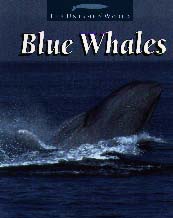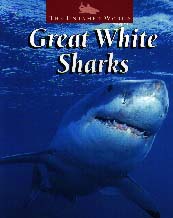|
________________
CM . . . .
Volume V Number 2 . . . . September 18, 1998
excerpts: Many land mammals are born helpless. They may be safely hidden in nests or carried by their mothers to protect them from harm. Whale infants, however, must be active and alert from birth. They need to be able to swim and follow their mothers. They have a lot to learn and they must learn it quickly.Part of "The Untamed World" wildlife series, each of these titles examines a fascinating sea creature. Chapter headings are almost identical in both books and range from the animal's features, social activities and habitat to its food, young, and its relationships with humans and other animals. One section dispels several myths surrounding the animal; another lists 20 fascinating - and they really are! - facts. Did you know, for example, that a small child could crawl through a blue whale's aorta, or that, in the Middle Ages, fossilized sharks' teeth were used to detect poison in food or drinks? When the tooth was dropped into a drink that contained an acid-based poison, the drink reportedly changed colour or began to fizz. What sets this series apart from other wildlife series is that it goes beyond the usual fare. One chapter, devoted to folklore, highlights sharks and whales as depicted in books, art and film. Another chapter, listing the pros and cons of a specific issue [keeping Great Whites in captivity, for instance], raises readers' awareness and fosters critical thinking. For those students who might wish to learn more about the animals and how to protect them, names and addresses of conservation groups follow the section on the problems facing the particular species. The books contain abundant, current and accurate information; they are well-organized with attractive layouts. Text is printed in a simple, medium-sized font. Words in boldface type, in the body of the text, appear in the glossary. Other features include a table of contents, an index and a suggested reading list. Plenty of coloured diagrams, charts, maps and photographs enhance the text and reinforce the concepts in each chapter. Worth noting is the fact that the vocabulary in Great White Sharks generally appears to be more difficult than that of Blue Whales. Highly recommended. Gail Hamilton is a teacher-librarian at Bird's Hill School in East St. Paul, Manitoba.
To comment on this title or this review, send mail to cm@umanitoba.ca.
Copyright © the Manitoba Library Association.
Reproduction for personal use is permitted only if this copyright notice
is maintained. Any other reproduction is prohibited without
permission.
Published by
TABLE OF CONTENTS FOR THIS ISSUE - SEPTEMBER 18, 1998.
AUTHORS |
TITLES |
MEDIA REVIEWS |
PROFILES |
BACK ISSUES |
SEARCH |
CMARCHIVE |
HOME
|


